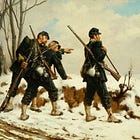The German infantry of 1914 was, for the most part, line infantry. That is to say, it was a direct descendant of the 18th century foot troops that moved, fired, and fought in close formations. The new firearms introduced in the second half of the 19th century had wrought some changes in the way line infantry fought. Nonetheless, the ideals of iron, unthinking discipline, steadiness under fire, volley fire, tightly packed formations, and, most important of all, the self-sacrificial bayonet charge, were very much alive in many German infantry units.
At the same time, however, there was a substantial body of German military opinion that favored infantry that fought in an entirely different, far more individualistic manner. These officers believed that individual aimed fire was more effective than volley fire. They believed that foot soldiers could move most effectively on the battle field, not in mass, but in small groups or even as individuals. Most importantly, they believed that the training of foot soldiers should place far less emphasis on instant, unthinking obedience and more on the cultivation of intelligence and initiative.
Proponents of this latter approach to infantry training and tactics could be found throughout the German Army of 1914. If, however, the grenadier and foot guard regiments of the Prussian Guard provided organizational basis for “line infantry thinking,” the Jäger battalions served as the natural home of the “light infantry mentality.”
First raised in Germany the early 18th century, Jäger battalions had always been composed largely of men who had been trained as hunters. (In German, the word Jäger means “hunter.”) Armed with rifles at a time when most foot troops were equipped with smooth-bore muskets, Jäger were traditionally used for the “war of posts.” When the army advanced, Jäger scouted ahead of the main body. When the army retreated, Jäger formed part of the rear guard. In all cases, there job was to ensure that enemy light troops kept a respectable difference from the main body and so permitted the general the freedom to move and maneuver his force.
Jäger battalions in the Prussian contingent traced their origins to the two Jäger companies formed by Frederick the Great in 1744. Recruited, as far as possible, from the sons of gamekeepers and other forest dwellers, these units were distinguished not merely for the marksmanship and stalking skill of the individual Jäger, but also for their loyalty. At a time when the ranks of the line infantry battalions contained large numbers of foreigners who had been tricked, coerced, and even kidnapped into lifetime enlistments, the Jäger were native Prussians who could look forward to retiring to positions of responsibility on royal and private hunting grounds. In an era when the discipline of other infantrymen was maintained by extensive corporal punishment, the most severe administrative punishment a Jäger could face was transfer to a line unit.
Sources: Peter Hofschröer, Prussian Light Infantry, 1792-1815 (London: Osprey, 1984); Curt Jany, Geschichte der Preußischen Armee vom 15. Jahrhundert bis 1914 (Osnabruck: Biblio Verlag, 1967); and Paul Pietsch, Die Formations und Uniformierungs-Geschichte des preußischen Heeres 1808-1914 (Hamburg: Verlag Helmut Gerhard Schulz, 1963)
For Further Reading:
.






Good intro. Some Jäger Units were mounted.